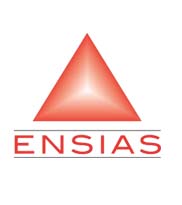- Accueil
-
L'Ecole
-
FORMATIONS
-
FORMATION INGENIEUR
-
Nouvelles filières offertes
- Ingénierie Intelligence Artificielle (2IA)
- Smart Supply Chain & Logistics (2SCL)
- Business Intelligence & Analytics (BI&A)
- Cybersécurité, Cloud et Informatique Mobile (CSCC)
- Data and Software Sciences (D2S)
- Génie de la Data (GD)
- Génie Logiciel (GL)
- Ingénierie Digitale pour la Finance (IDF)
- Smart System Engineering (SSE)
- REGLEMENT DES ETUDES DE L’ENSIAS CYCLE INGENIEUR
-
Nouvelles filières offertes
-
FORMATION INGENIEUR
- FORMATION CONTINUE
-
Recherche
- INTERNATIONAL
- ENTREPRISES
- VIE ESTUDIANTINE
- BIBLIOTHEQUE
LES DERNIÈRES INFORMATIONS
Optimization of vehicle routing problem in the context of reverse logistics of handling containers in closed loop
| Titre | Optimization of vehicle routing problem in the context of reverse logistics of handling containers in closed loop |
| Publication Type | Conference Paper |
| Year of Publication | 2017 |
| Authors | Bouanane, K, Benadada, Y, Marcotte, S |
| Conference Name | Proceedings of the International Conference on Industrial Engineering and Operations Management |
| Abstract | Reverse logistics aims at the optimization of the delivery of goods from depots to customers and the simultaneous collection of waste or used products from customers to depots or specialized recycling sites. In this framework, classical routing problems such as vehicle routing problem must be reformulated to take into account simultaneously both goods delivery and used containers collection. In Vehicle Routing Problem with Simultaneous Pickup and Delivery (VRPSPD), vehicles can accomplish pickup and delivery processes in each node simultaneously and the whole loading products should be returned to the depot. The importance of reverse logistics increased the importance of VRPSPD. Due to the development of communication and information technology, and the increasing pressure of transportation cost, many companies choose the joint distribution of multiple depots because it can obtain more saving cost than traditional fixed zone service of single depot. This paper aims to study the Multi Depot Vehicle Routing Problem with Simultaneous Pickup and Delivery and Inventory Restrictions. What makes this problem special is the depots capacities. In reality, the optimal distribution of different goods from potentially multiple depots to customers depends on the inventory levels in the depots. Each depot has a capacity and the capacities of depots are not same as each other. We distinguish two storage areas in each depot, one for product to be delivered to customers and the other for product picked up from customers. Customers can only be served if sufficient stock of the requested product is available. Similarly, a collection request can only be satisfied if there is sufficient space in the corresponding stock. The problem is defined as follows: given several depots with defined stock levels, find the lowest-cost routes such that the known delivery and pick-up demands of a set of customers is satisfied and the capacity and inventory constraints of vehicles and depots are not violated. There seems to exist no model that captures this interaction between simultaneous pick-up and delivery and inventory constrains. © IEOM Society International. |
| URL | https://www.scopus.com/inward/record.uri?eid=2-s2.0-85018972722&partnerID=40&md5=63b2cdc02b2d2b49055a21c5f4857501 |
Revues:
LIENS UTILES
Localisation
Contactez-nous
ENSIAS
 Avenue Mohammed Ben Abdallah Regragui, Madinat Al Irfane, BP 713, Agdal Rabat, Maroc
Avenue Mohammed Ben Abdallah Regragui, Madinat Al Irfane, BP 713, Agdal Rabat, Maroc
![]() Télécopie : (+212) 5 37 68 60 78
Télécopie : (+212) 5 37 68 60 78
![]() Secrétariat de direction : 06 61 48 10 97
Secrétariat de direction : 06 61 48 10 97
Secrétariat général : 06 61 34 09 27
Service des affaires financières : 06 61 44 76 79
Service des affaires estudiantines : 06 62 77 10 17 / n.mhirich@um5s.net.ma
CEDOC ST2I : 06 66 39 75 16
Résidences : 06 61 82 89 77
Education - This is a contributing Drupal Theme
Design by WeebPal.
Design by WeebPal.



































